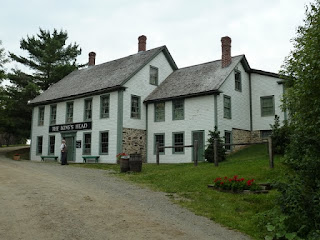There's quite a bit to see and do on PEI, although most of it is pretty simple fare. The islanders seem to take a lot of pride in most of it, though, and everyone I met would recommend places I should visit.
 |
| A spooky old house that I liked. |
I'll start by talking about the one major thing I
didn't see, and that was anything having to do with
Anne of Green Gables. I suspect that when most Americans are asked what they know about PEI, they manage to stammer out the name of that book (well, at least that's all
I knew about the island before my visit) and indeed, it seems to be the most famous thing about the area. But I worried before I went that all of the Anne sites would be really cheesy. So I asked the locals and other people I met in Canada who had been there, and they all agreed the Anne sites were both cheesy
and too crowded with tourists. So I spend my time on other things.
 |
| A spooky old, abandoned church. |
One unusual stop was the Fox Museum and Hall of Fame, a donation-based, one-room museum dedicated to PEI's fox pelt industry of the 20th Century. I somehow missed the inductees into the Hall of Fame ... where they foxes or farmers? I'll never know.
 |
| A potential fox hall-of-famer. |
Another unusual stop was the Bottle House... well, actually three houses made entirely of bottles held in place my cement. Some guy several decades ago decided to build these building out of abandoned bottles, then locals and visitors starting bringing him more bottles to help his work. There's something like 10,000+ bottles per house. Kitschy, but fun.
 |
| The alter of the bottle church. |
The Potato Museum was another stop. Potatoes were (and still are I think) one of the major industries of PEI. In fact, it produces more potatoes than any other Canadian province. Among other things, I learned that the potato originated in the Andes and were used and worshiped extensively by the Incas. (I also just learned that "worshiped" has only one P.) All along my international trip, I liked seeing how the culture of one country would blend into the next country, through things like religion, art, food, clothing, etc. So I unexpectedly got to see how the culture of my last stop on the world tour (Peru) merged into the present day culture of PEI.
 |
| Is the exhibit or the potato the amazing thing? Or both? |
 |
| Incan potato pottery. |
I lucked out on the day I went to the Potato Museum. Its city, O'Leahy, was hosting its week-long Potato Blossom Festival, and I arrived in time to watch the parade! O'Leahy is a
small town, so I figure half of its citizens were in the parade, and the other half were watching along the route. I was told it's pretty common for all the little towns around the island to have festival days, you just have to ask around to find out which town is holding a festival in any given week.
 |
| I heard she performed the same talent as the girl in Little Miss Sunshine. Only with some potatoes thrown in. |
 |
| Look out, D.C. Cowboys! |
 |
| Um... yeah. |
That same day I stopped at the Acadien Museum. Have you heard of
the Acadians? I had not, until my visit here. They were colonists from France who settled in the three maritime provinces in the 17th Century, then were treated
very badly by England when the provinces became English-governed. Many of them (or their descendants more likely) returned to the area many years later, and they continue to speak in French and maintain many of the traditions of their ancestors. I'm writing out of turn here, but the town I visited today in Nova Scotia -- Cheticamp -- also has a large Acadie population.
 |
| The Acadie flag. |
Finally, I popped into a few graveyards around the Island. I unknowingly (at the time) stopped at one of the most famous Acadie graveyards. I liked it, as it overlooked farms in one direction, and the water immediately behind it.
Oh, last tidbit about my travels around PEI. There are still lots of unpaved roads (which were a bit harrowing when wet from the rain!) and they are all this same shade of copper-orange. The same color as my car, in fact, which prompted a local to note he couldn't tell if my car was clean or dirty, because it was the same color as the island mud!
 |
| From now on, I'll tell people the color of my car is "Prince Edward Island." |


























































